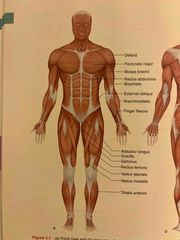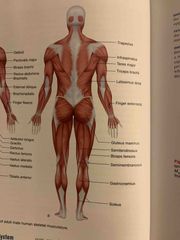![]()
![]()
![]()
Use LEFT and RIGHT arrow keys to navigate between flashcards;
Use UP and DOWN arrow keys to flip the card;
H to show hint;
A reads text to speech;
11 Cards in this Set
- Front
- Back
|
Name and provide an example of each of the three types of joints. |
Fibrous- virtually no movement: sutures of the skull Cartilaginous- limited movement: disks Synovial- allow considerable movement: elbow, knee |
|
|
Name the three types of joints in relation to their direction of rotation. |
Uniaxial- hinges, rotate around one axis: elbow Biaxial- allow movement on two axes: ankle and wrist Multiaxial: movement about all 3 axes: shoulder & hip |
|
|
Locate the adductor longus, gracilis and sartorius. |

Back (Definition) |
|
|
Locate the infraspinatus, teres major, semitendinosis, bicep Femoris and semimembranosus. |

Back (Definition) |
|
|
What is the fulcrum? |
The pivot point of a lever. |
|
|
What is a lever? Name the three classes. |
A rigid body that, when subjected to force, exerts force on any object impeding its tendency to rotate. First-class: muscle force and resistive force act on opposite sides of fulcrum. Forearm-elbow extension against resistance. Second: muscle force and resistive force on same side of fulcrum, with muscle force acting through moment arm longer than what the resistance force acts. Foot: plantar flex room against resistance. Third: muscle force acting through moment arm shorter than what the resistance force acts. The forearm in elbow flexion against resistance. |
|
|
Force = |
Mass x Acceleration |
|
|
Work = |
Force x Distance |
|
|
Power = |
Work / Time |
|
|
The upward force an athlete exerts equals: |
The weight lifted plus any intertial force, which is mass times the upward acceleration of the bar. |
|
|
Strength is defined as: |
The maximal force that a muscle or muscle group can generate at a specified velocity. |

